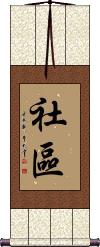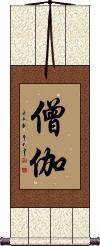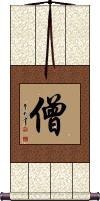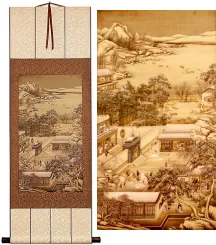Many custom options...
And formats...

Community in Chinese / Japanese...
Buy a Community calligraphy wall scroll here!
Personalize your custom “Community” project by clicking the button next to your favorite “Community” title below...
Community
社區 is how to write community in Chinese.
社區 can mean the neighborhood you live in. It can also be used the same way we use the word community in English.
Examples: African-American community, Christian community, Asian community, etc.
If you need a special calligraphy wall scroll to describe your community, just contact me, and I’ll translate it and make it for you.
Sangha
In Buddhism, 僧伽 refers to a community of monks and/or nuns (one of the “Three Jewels”). In general terms, it can simply mean “all followers of the Buddha.”
Notes: Though there are not vast numbers of Chinese Hindus, in the Hindu faith, this term means “community together.”
The original Sanskrit word is also Romanized as samgha.
The first character means “monk.” The second character means Buddha or Shakyamuni.
僧伽 is a transliteration of the original Sanskrit, but it uses two very profound Chinese characters related to Buddhism.
Some may pronounce this as “seng qie” or “seng jia” in Mandarin (two possible pronunciations for the second character). Note that “qie” sounds like “chee-ah” using typical English pronunciation. Chinese Romanization is not actually designed to match English sounds.
![]()
![]() Note that when writing this as Kanji, Japanese will tend to write the first character in the form shown to the right. If you select our Japanese master calligrapher, please expect this special Kanji form. However, it should also be noted that this is not a common term in Japanese (except by certain sects of Buddhism or perhaps devout Buddhists in Japan).
Note that when writing this as Kanji, Japanese will tend to write the first character in the form shown to the right. If you select our Japanese master calligrapher, please expect this special Kanji form. However, it should also be noted that this is not a common term in Japanese (except by certain sects of Buddhism or perhaps devout Buddhists in Japan).
Sangha / Order of Monks
僧 is the single-character or short form of Sangha, the Buddhist idea of community or order (of monks, nuns, or followers of the Buddha).
Alone, this character can simply mean “monk” (Just means monk in Japanese).
![]()
![]() Note that when writing this as Kanji, Japanese will tend to write this in the form shown to the right. If you select our Japanese master calligrapher, please expect this special Kanji form.
Note that when writing this as Kanji, Japanese will tend to write this in the form shown to the right. If you select our Japanese master calligrapher, please expect this special Kanji form.
This in-stock artwork might be what you are looking for, and ships right away...
Gallery Price: $108.00
Your Price: $59.88
These search terms might be related to Community:
Body and Earth in Unity
Collaboration / Cooperation / Synergy
Cooperation
Cooperation / Collaboration
Do Not Fear the Task: Cooperation Will Lead to Success
One Mind / Unity
Oneness / Unity
Strength and Love in Unity
Unite / Unity
Unity / United / Solidarity / Cooperation
Working Together as One / Cooperation
Not the results for community that you were looking for?
Below are some entries from our dictionary that may match your community search...
| Characters If shown, 2nd row is Simp. Chinese |
Pronunciation Romanization |
Simple Dictionary Definition |
僧 see styles |
sēng seng1 seng sou / so そう |
More info & calligraphy: Sangha / Order of Monks(1) monk; priest; (2) (abbreviation) (See 僧伽・そうぎゃ) sangha (the Buddhist community); (surname) Sou 僧伽 saṅgha, an assembly, collection, company, society. The corporate assembly of at least three (formerly four) monks under a chairman, empowered to hear confession, grant absolution, and ordain. The church or monastic order, the third member of the triratna. The term 僧 used alone has come to mean a monk, or monks in general. Also僧佉, 僧加, 僧企耶.; A fully ordained monk, i.e. a bhikṣu as contrasted with the śramaņa. |
律 see styles |
lǜ lu:4 lü ritsuji りつじ |
More info & calligraphy: Ritsu(1) law (esp. ancient East Asian criminal code); regulation; (2) {Buddh} vinaya (rules for the monastic community); (3) (abbreviation) (See 律宗) Ritsu (school of Buddhism); (4) (abbreviation) (See 律詩) lüshi (style of Chinese poem); (5) (also りち) (musical) pitch; (6) (See 十二律,呂・2) six odd-numbered notes of the ancient chromatic scale; (7) (abbreviation) (See 律旋) Japanese seven-tone gagaku scale, similar to Dorian mode (corresponding to: re, mi, fa, so, la, ti, do); (n,n-suf,ctr) (8) step (in traditional Eastern music, corresponding to a Western semitone); (personal name) Ritsuji vinaya, from vi-ni, to 1ead, train: discipline: v. 毘奈耶; other names are Prātimokṣa, śīla, and upalakṣa. The discipline, or monastic rules; one of the three divisions of the Canon, or Tripiṭaka, and said to have been compiled by Upāli. |
三宝 see styles |
sanpou / sanpo さんぽう |
{Buddh} the Three Jewels; the Triple Gem; Triratna; the Three Treasures; Buddha, Dharma, Sangha; Buddha, the teachings of Buddha, and the community of monks and nuns; (surname) Sanpou |
僧伽 see styles |
sēng qié seng1 qie2 seng ch`ieh seng chieh sougya / sogya そうぎゃ |
More info & calligraphy: Sanghasangha (the Buddhist community) (san: samgha) (Skt. saṃgha) |
社區 社区 see styles |
shè qū she4 qu1 she ch`ü she chü |
More info & calligraphy: CommunitySee: 社区 |
釋迦牟尼 释迦牟尼 see styles |
shì jiā móu ní shi4 jia1 mou2 ni2 shih chia mou ni Shakamuni |
More info & calligraphy: Shakyamuni / The Buddha釋迦文 (釋迦文尼); 釋伽文 Śākyamuni, the saint of the Śākya tribe. muni is saint, holy man, sage, ascetic monk; it is: intp. as 仁 benevolent, charitable, kind, also as 寂默 one who dwells in seclusion. After '500 or 550' previous incarnations, Śākyamuni finally attained to the state of Bodhisattva, was born in the Tuṣita heaven, and descended as a white elephant, through her right side, into the womb of the immaculate Māyā, the purest woman on earth; this was on the 8th day of the 4th month; next year on the 8th day of the 2nd month he was born from her right side painlessly as she stood under a tree in the Lumbinī garden. For the subsequent miraculous events v. Eitel. also the 神通遊戲經 (Lalitavistara), the 釋迦如來成道記, etc. Simpler statements say that he was born the son of Śuddhodana, of the kṣatriya caste, ruler of Kapilavastu, and Māyā his wife; that Māyā died seven days later, leaving him to be brought up by her sister Prājapati; that in due course he was married to Yaśodharā who bore him a son, Rāhula; that in search of truth he left home, became an ascetic, severely disciplined himself, and finally at 35 years of age, under a tree, realized that the way of release from the chain of rebirth and death lay not in asceticism but in moral purity; this he explained first in his four dogmas, v. 四諦 and eightfold noble way 八正道, later amplified and developed in many sermons. He founded his community on the basis of poverty, chastity, and insight or meditation, ad it became known as Buddhism, as he became known as Buddha, the enlightened. His death was probably in or near 487 B.C., a few years before that of Confucius in 479. The sacerdotal name of his family is Gautama, said to be the original name of the whole clan, Śākya being that of his branch, v. 瞿, 喬.; his personal name was Siddhārtha, or Sarvārthasiddha, v. 悉. |
函 see styles |
hán han2 han hako はこ |
envelope; case; letter (1) box; case; chest; package; pack; crate; (2) car (of a train, etc.); (3) shamisen case; shamisen; (4) (colloquialism) public building; community building; (5) (archaism) man who carries a geisha's shamisen; (6) (archaism) receptacle for human waste; feces (faeces); (suf,ctr) (7) counter for boxes (or boxed objects) |
凾 see styles |
hán han2 han kan はこ |
(1) box; case; chest; package; pack; crate; (2) car (of a train, etc.); (3) shamisen case; shamisen; (4) (colloquialism) public building; community building; (5) (archaism) man who carries a geisha's shamisen; (6) (archaism) receptacle for human waste; feces (faeces); (suf,ctr) (7) counter for boxes (or boxed objects) A box, receptacle; to enfold: a letter. |
匣 see styles |
xiá xia2 hsia hako はこ kushige くしげ |
box (1) box; case; chest; package; pack; crate; (2) car (of a train, etc.); (3) shamisen case; shamisen; (4) (colloquialism) public building; community building; (5) (archaism) man who carries a geisha's shamisen; (6) (archaism) receptacle for human waste; feces (faeces); (suf,ctr) (7) counter for boxes (or boxed objects); (archaism) toiletries case |
界 see styles |
jiè jie4 chieh sakai さかい |
(bound form) boundary; border; (bound form) realm (suffix noun) (1) community; circles; world; (n,n-suf) (2) {biol} kingdom; (n,n-suf) (3) {geol} erathem; (suffix noun) (4) field (electrical); (5) border; boundary; division; (place-name, surname) Sakai dhātu. 馱都 Whatever is differentiated; a boundary, limit, region; that which is contained or limited, e. g. the nature of a thing; provenance; a species, class, variety; the underlying principle; the root or underlying principles of a discourse. |
筐 see styles |
kuāng kuang1 k`uang kuang shou / sho しょう |
basket; CL:隻|只[zhi1] (1) box; case; chest; package; pack; crate; (2) car (of a train, etc.); (3) shamisen case; shamisen; (4) (colloquialism) public building; community building; (5) (archaism) man who carries a geisha's shamisen; (6) (archaism) receptacle for human waste; feces (faeces); (suf,ctr) (7) counter for boxes (or boxed objects); (archaism) fine-meshed bamboo basket; (personal name) Shou |
筥 see styles |
jǔ ju3 chü hakozaki はこざき |
round bamboo basket (1) box; case; chest; package; pack; crate; (2) car (of a train, etc.); (3) shamisen case; shamisen; (4) (colloquialism) public building; community building; (5) (archaism) man who carries a geisha's shamisen; (6) (archaism) receptacle for human waste; feces (faeces); (suf,ctr) (7) counter for boxes (or boxed objects); (surname) Hakozaki |
箱 see styles |
xiāng xiang1 hsiang hakozaki はこざき |
box; trunk; chest (1) box; case; chest; package; pack; crate; (2) car (of a train, etc.); (3) shamisen case; shamisen; (4) (colloquialism) public building; community building; (5) (archaism) man who carries a geisha's shamisen; (6) (archaism) receptacle for human waste; feces (faeces); (suf,ctr) (7) counter for boxes (or boxed objects); (surname) Hakozaki |
CB see styles |
shii bii; shiibii(sk) / shi bi; shibi(sk) シー・ビー; シービー(sk) |
(1) Citizens' Band; CB (radio); (2) (See 転換社債) convertible bond; (3) (See 慢性気管支炎) chronic bronchitis; (4) chemical and biological (weapons); (5) {sports} (See センターバック) center back; centre back; (6) community business |
EC see styles |
ii shii; iishii(sk) / i shi; ishi(sk) イー・シー; イーシー(sk) |
(1) European Community; EC; (2) (See エレクトロニックコマース) e-commerce; electronic commerce; (3) (See 緊急避妊) emergency contraception; (4) engineering constructor |
三尊 see styles |
sān zūn san1 zun1 san tsun sanzon; sanson さんぞん; さんそん |
(1) (さんぞん only) {Buddh} Buddha triad; image of a Buddha attended by two Bodhisattvas; (2) (さんぞん only) {Buddh} (See 三宝) The Three Jewels; Buddha, the teachings of Buddha, and the community of monks and nuns; (3) (さんぞん only) (See 三尊天井) head and shoulders (stock price, etc. chart pattern); (4) the three people one must esteem: master, father, teacher The three honoured ones: Buddha, the Law, the Ecclesia or Order. Others are: Amitābha, Avalokiteśvara, and Mahāsthāmaprāpta, who, according to the Pure-land sect, come to welcome the dying invoker. Another group is Bhaiṣajya, Vairocana, and Candraprabha; and another, Śākyamunī, Mañjuśrī, and Samantabhadra. |
主柱 see styles |
shuchuu / shuchu しゅちゅう |
(1) (See 大黒柱・1) central pillar; (2) (See 大黒柱・2) principal post; backbone of a society or community |
五逆 see styles |
wǔ nì wu3 ni4 wu ni gogyaku ごぎゃく |
(1) {Buddh} five cardinal sins (killing one's father, killing one's mother, killing an arhat, shedding the blood of a Buddha, causing a schism within the sangha); (2) (hist) crime of killing one's master, father, grandfather, mother, or grandmother pañcānantarya; 五無間業 The five rebellious acts or deadly sins, parricide, matricide, killing an arhat, shedding the blood of a Buddha, destroying the harmony of the sangha, or fraternity. The above definition is common both to Hīnayāna and Mahāyāna. The lightest of these sins is the first; the heaviest the last. II. Another group is: (1) sacrilege, such as destroying temples, burning sutras, stealing a Buddha's or a monk's things, inducing others to do so, or taking pleasure therein; (2) slander, or abuse of the teaching of śrāvaka s, pratyekabuddhas, or bodhisattvas; (3) ill-treatment or killing of a monk; (4) any one of the five deadly sins given above; (5) denial of the karma consequences of ill deeds, acting or teaching others accordingly, and unceasing evil life. III. There are also five deadly sins, each of which is equal to each of the first set of five: (1) violation of a mother, or a fully ordained nun; (2) killing a bodhisattva in a sangha; (5) destroying a Buddha's stūpa. IV. The five unpardonable sin of Devadatta who (1) destroyed the harmony of the community; (2) injured Śākyamuni with a stone, shedding his blood; (3) induced the king to let loose a rutting elephant to trample down Śākyamuni; (4) killed a nun; (5) put poison on his finger-nails and saluted Śākyamuni intending to destroy him thereby. |
人流 see styles |
rén liú ren2 liu2 jen liu jinryuu / jinryu じんりゅう |
stream of people; abortion; abbr. for 人工流產|人工流产[ren2 gong1 liu2 chan3] population flow; movement of people; flow of people; community mobility |
僧門 僧门 see styles |
sēng mén seng1 men2 seng men soumon / somon そうもん |
priesthood; Buddhism Buddhist monastic community |
共報 共报 see styles |
gòng bào gong4 bao4 kung pao gūhō |
Collective retribution; reward or punishment of the community, or in common, for the 共業 deeds of the community, or even of the individual in their effects on the community. |
共聴 see styles |
kyouchou / kyocho きょうちょう |
(can act as adjective) (abbreviation) (See 共同視聴) community; shared |
出圈 see styles |
chū quān chu1 quan1 ch`u ch`üan chu chüan |
to gain popularity beyond the original niche community or fan base; to go mainstream |
別請 别请 see styles |
bié qǐng bie2 qing3 pieh ch`ing pieh ching besshō |
Special deference paid by singling out or inviting one member of the community; which procedure is against monastic rules. |
化緣 化缘 see styles |
huà yuán hua4 yuan2 hua yüan keen |
(of a monk) to beg The cause of a Buddha's or bodhisattva's coming to the world, i. e. the transformation of the living; also, a contribution to the needs of the community. |
和僧 see styles |
hé sēng he2 seng1 ho seng wasō わそう |
(archaism) (vocative) monk (familiar or derogatory) (和合僧); 和衆 (和合衆) A saṃgha 僧伽, a monastery. |
商界 see styles |
shāng jiè shang1 jie4 shang chieh |
business world; business community |
四衆 四众 see styles |
sì zhòng si4 zhong4 ssu chung shishu; shishuu / shishu; shishu ししゅ; ししゅう |
(1) four orders of Buddhist followers (monks, nuns, male lay devotees and female lay devotees); (2) four monastic communities (ordained monks, ordained nuns, male novices and female novices); (3) (in Tendai) the four assemblies The four varga (groups, or orders), i. e. bhikṣu, bhikṣuṇī, upāsaka and upāsikā, monks, nuns, male and female devotees. Another group, according to Tiantai's commentary on the Lotus, is 發起衆 the assembly which, through Śāriputra, stirred the Buddha to begin his Lotus Sutra sermons; 當機衆 the pivotal assembly, those who were responsive to him; 影向衆 the reflection assembly, those like Mañjuśrī, etc., who reflected on, or drew out the Buddha's teaching; and 結緣衆 those who only profited in having seen and heard a Buddha, and therefore whose enlightenment is delayed to a future life. |
圈內 圈内 see styles |
quān nèi quan1 nei4 ch`üan nei chüan nei |
among insiders; within the community (of publishers, cyclists or cosplayers etc); (esp.) in show business circles |
夏厨 see styles |
natsuchuu / natsuchu なつちゅう |
(net-sl) (derogatory term) summerfag; young and inexperienced user who joins an online community during the summer |
Click here for more community results from our dictionary
The following table may be helpful for those studying Chinese or Japanese...
| Title | Characters | Romaji (Romanized Japanese) | Various forms of Romanized Chinese | |
| Community | 社區 社区 | shè qū / she4 qu1 / she qu / shequ | she ch`ü / shechü / she chü | |
| Sangha | 僧伽 | sougya / sogya | sēng qié / seng1 qie2 / seng qie / sengqie | seng ch`ieh / sengchieh / seng chieh |
| Sangha Order of Monks | 僧 | sou / so | sēng / seng1 / seng | |
| In some entries above you will see that characters have different versions above and below a line. In these cases, the characters above the line are Traditional Chinese, while the ones below are Simplified Chinese. | ||||
Successful Chinese Character and Japanese Kanji calligraphy searches within the last few hours...








